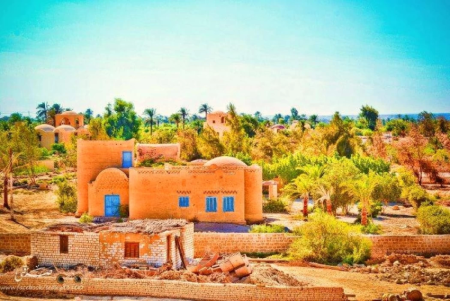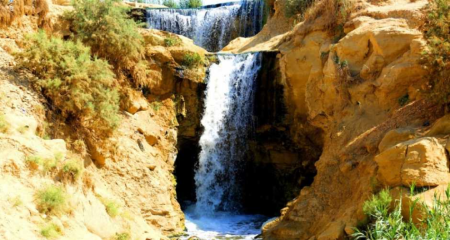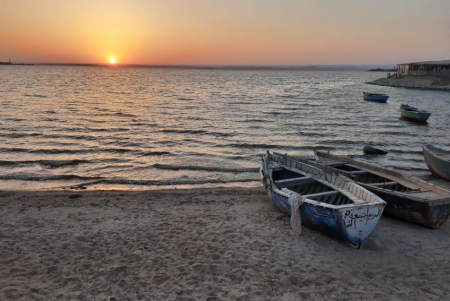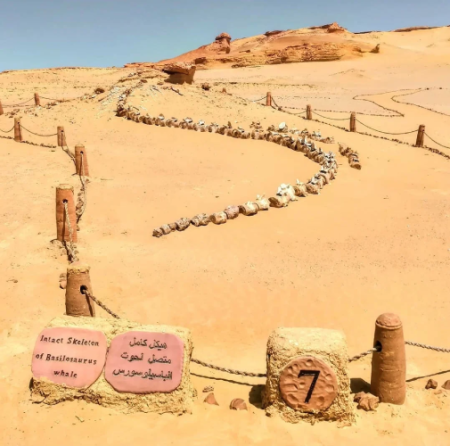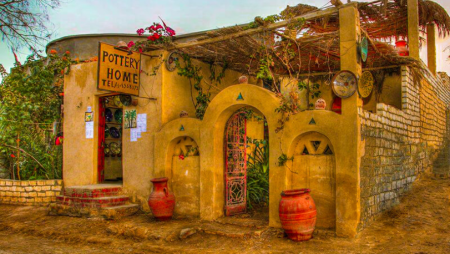Wadi el Hitan Egypt
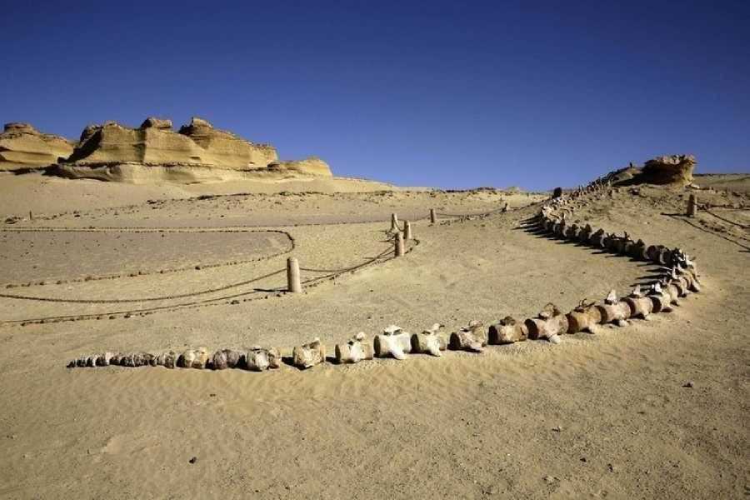
Wadi El Hitan Egypt – The Valley of Whales, a Timeless Desert Treasure
Deep in the heart of the Western Desert, Wadi El Hitan Egypt, or the ‘Valley of the Whales,’ unfolds an ancient story written in stone and sand. Located about 150 kilometers southwest of Fayoum City, this UNESCO World Heritage Site is a living museum that captures one of the most extraordinary chapters in Earth’s history—the evolution of whales from land-dwelling mammals to ocean giants. The golden dunes, sculpted over millennia by wind and time, cradle hundreds of fossilized whale skeletons dating back around 40 million years. These remnants offer a surreal glimpse into a bygone age when this desert was submerged under a vast sea teeming with life.
Beyond its paleontological significance, Wadi El Hitan’s raw beauty and untouched serenity make it a dream destination for eco-travelers, adventurers, and history buffs alike. The silence of the desert amplifies the whispers of ancient tides, and each fossil tells a story of transformation and survival. Wadi El Hitan Egypt isn’t just an archaeological treasure—it’s an emotional journey through time, evolution, and Earth’s majestic resilience. Visitors who venture here don’t just see history; they feel it beneath their feet. The site forms part of the Wadi El Rayan Protected Area, merging stunning natural landscapes with scientific wonder, making it a must-visit highlight for those exploring Egypt Desert Tours or those yearning to uncover the country’s lesser-known natural marvels.
The Geological Wonders of Wadi El Hitan Egypt
The terrain of Wadi El Hitan is a masterpiece etched by time. Layers of limestone and sandstone reveal a fascinating geological timeline, marking shifts in climate, water levels, and biodiversity. Scientists believe the area was once part of the ancient Tethys Sea, a warm, shallow ocean that existed millions of years before the Sahara’s formation. Over eons, receding waters left behind sedimentary deposits that preserved marine fossils with stunning clarity. It’s this geological record that makes Wadi El Hitan Egypt a priceless open-air archive for studying both natural history and climatic evolution.
Visitors can easily distinguish the preserved whale fossils along well-marked trails. Each fossilized skeleton—some over 20 meters long—illustrates how species such as Basilosaurus and Dorudon adapted to life in water. Their elongated body structures, vestigial hind limbs, and sharp teeth narrate the shift from land-based locomotion to aquatic mastery. It’s a mind-bending reminder that deserts were once oceans and that life on Earth is in perpetual motion. These fossils have captivated researchers and travelers alike, placing Wadi El Hitan among the most important paleontological sites in the world, alongside other great wonders like The White Desert of Egypt.
The Ancient Sea That Became a Desert
Imagine standing where waves once crashed and marine creatures thrived. Around 40 million years ago, Wadi El Hitan was an oceanic paradise filled with now-extinct species. The fossils uncovered here include not only whales but also sea cows, sharks, and even ancient turtles. The gradual movement of tectonic plates transformed this underwater world into the desert we see today. The erosion patterns etched into the rocks testify to the incredible natural forces that reshaped this region. For geologists, Wadi El Hitan Egypt remains an invaluable classroom—a place where Earth’s dramatic narrative unfolds in vivid detail.
Whale Fossils and Evolutionary Marvels
Among the most celebrated finds in Wadi El Hitan are the fossils of Basilosaurus isis, an ancient whale species that bridged the evolutionary gap between terrestrial and aquatic animals. Its elongated vertebrae and rudimentary hind limbs demonstrate an evolutionary transition that forever changed life in the seas. Dorudon atrox, another significant species, provides clues about adaptation, diet, and reproduction. The remarkable preservation of these fossils—often found intact—has allowed scientists to reconstruct entire skeletons, offering an unparalleled view into evolutionary biology. For anyone with even a passing interest in science, Wadi El Hitan Egypt offers a tangible connection to one of nature’s most profound transformations.
UNESCO World Heritage Recognition
In 2005, Wadi El Hitan was inscribed as a UNESCO World Heritage Site, recognized for its exceptional universal value. This designation underscores its global significance as a record of early whale evolution and a natural laboratory for studying ancient ecosystems. The UNESCO recognition brought global attention to Egypt’s efforts in preserving natural heritage sites beyond its pharaonic landmarks such as the Great Pyramids of Giza. Conservation work in Wadi El Hitan includes sustainable tourism initiatives, eco-lodging, and educational exhibits housed at the Fossil and Climate Change Museum—an architectural gem that blends seamlessly with the surrounding desert landscape.
Eco-Tourism and Sustainable Travel in Wadi El Hitan
Wadi El Hitan Egypt has also emerged as a model for sustainable tourism. Access to the area is controlled to minimize environmental impact, and visitors are encouraged to explore guided trails without disturbing the fragile ecosystem. Eco-lodges built nearby use solar energy and environmentally friendly materials, providing an authentic desert experience while preserving the area’s integrity. Adventure seekers often combine their visits with nearby attractions such as Wadi El Rayan waterfalls and Qarun Lake. Together, these destinations form the heart of Fayoum’s eco-tourism circuit, where desert safaris meet geological storytelling and ancient wonders merge with modern conservation.
How to Reach Wadi El Hitan Egypt
Reaching Wadi El Hitan is part of the adventure. From Cairo city, travelers can embark on a 3-hour drive heading southwest through the Fayoum depression. The route winds past lush farmland, salt lakes, and small villages before the desert horizon unfolds. Travelers often include Wadi El Hitan in curated itineraries with Egypt Excursions or extended Egypt Travel Packages that combine archaeology, desert adventure, and natural beauty. Because of its protected status, access typically requires a permit, easily arranged through authorized tour operators or the Fayoum Tourism Office.
For those craving a dose of adventure, 4x4 vehicles are recommended, as the final stretch to Wadi El Hitan cuts through soft sand and rugged terrain. The journey itself is mesmerizing—passing through desolate plains where silence reigns supreme. Guided tours often include a stop at Tunis Village Faiyum, a charming artisans’ community known for its distinctive pottery and local cuisine. Visitors can savor traditional Egyptian dishes before continuing toward the valley’s fossil-rich heart.
Best Time to Visit Wadi El Hitan Egypt
The ideal time to explore Wadi El Hitan is between October and April when temperatures remain moderate and the desert light turns golden and soft. The cooler months make hiking more comfortable, allowing travelers to fully savor the natural splendor without the harsh heat of summer. During sunrise and sunset, the valley’s sandstone formations glow in shades of amber and copper, creating an atmospheric backdrop that photographers adore. Many travelers pair their visit with nearby adventures like Egypt Vacations Packages that explore both desert and Nile destinations, offering a comprehensive experience of Egypt’s diverse landscapes.
Activities and Experiences Around Wadi El Hitan
Beyond fossil exploration, the Wadi El Hitan area invites travelers to hike, stargaze, and camp under pristine night skies. The absence of urban light pollution transforms the desert into a celestial theater where constellations shimmer vividly. Some tours include overnight stays, where Bedouin guides share stories around a campfire—a timeless ritual that connects visitors with the land’s ancient rhythms. For those seeking a more luxurious touch, combining the experience with a cruise along Egypt Nile Cruises offers a stunning contrast between desert austerity and the fertile banks of the Nile.
Preserving Egypt’s Natural and Scientific Heritage
Egypt’s allure extends far beyond its temples and monuments. Wadi El Hitan represents a commitment to protecting scientific heritage alongside cultural legacy. Its preservation serves as a blueprint for other natural sites, aligning with global efforts to combat climate change and biodiversity loss. Conservation projects have introduced educational programs for local communities, encouraging sustainable livelihoods through tourism and conservation work. This synergy between science and sustainability ensures that Wadi El Hitan Egypt remains a beacon of balance between nature, history, and human stewardship.
Why Wadi El Hitan Should Be on Every Traveler’s Bucket List
Wadi El Hitan isn’t merely a destination—it’s an awakening. Standing amid ancient whale fossils, surrounded by the silence of infinite dunes, travelers often experience a profound connection to the planet’s history. It’s not just about observing; it’s about feeling time itself slow down. Whether you’re an adventurer, nature lover, or history enthusiast, this valley offers a once-in-a-lifetime experience that captures the soul of Egypt beyond its well-trodden paths. For those crafting their ultimate Egypt bucket list, Wadi El Hitan is an unmissable gem—a place where evolution, geology, and beauty converge.
FAQs About Wadi El Hitan Egypt
What is the significance of Wadi El Hitan Egypt?
Wadi El Hitan is globally recognized as the site that documents the evolution of whales from land mammals to aquatic creatures. Its fossils provide irrefutable evidence of this transformation, making it an essential place for understanding evolutionary biology and Earth’s ancient history.
Where is Wadi El Hitan located?
Wadi El Hitan lies within the Fayoum Governorate, about 150 kilometers southwest of Cairo, inside the Wadi El Rayan Protected Area. The journey offers scenic desert views, making it a popular addition to top day trips from Cairo.
Can I visit Wadi El Hitan without a guide?
While it’s possible to reach the area independently, visitors are highly encouraged to go with official guides or tour operators to ensure protection of the fossils and adherence to conservation rules. Guided tours also enhance understanding of the site’s scientific and geological importance.
What should I bring when visiting Wadi El Hitan?
Essential items include comfortable walking shoes, sunscreen, hats, plenty of water, and a camera. Since facilities are limited, it’s wise to carry snacks and ensure your vehicle is suitable for desert terrain. Overnight visitors should bring warm clothing, as temperatures drop significantly after sunset.
Is Wadi El Hitan suitable for family visits?
Yes, Wadi El Hitan Egypt is family-friendly, offering educational experiences for children and adults alike. The site’s museum and guided trails make learning about ancient marine life fascinating and interactive, providing a memorable adventure for families exploring Egypt’s natural heritage.


